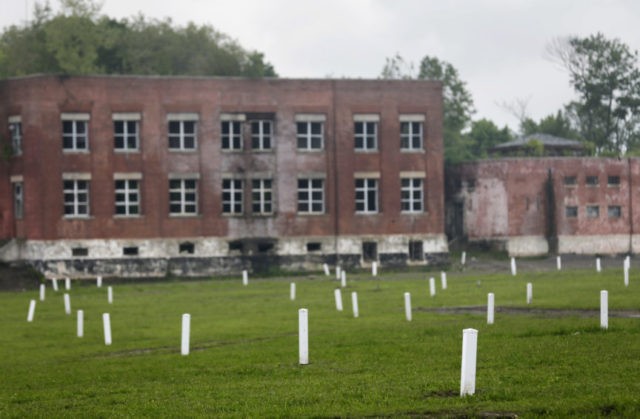NEW YORK (AP) — Prisoners working as gravediggers stack wooden coffins in the ground, three at a time. Wild geese and newborn goslings roam the grassy fields near small white statues of angels. Decaying brick buildings with blown-out windows stand overhead.
A small island in the waters off the Bronx that holds the remains of about 1 million deceased New Yorkers has long been shrouded in secrecy, with limited public access.
But the city’s Department of Correction, which operates Hart Island, partially opened it to reporters this week for a rare look at the site that has served as New York City’s potter’s field for nearly 150 years.
Journalists were allowed Wednesday to photograph only parts of the 131-acre island, a sprawling cemetery of white markers on green lawns. Photographs were not allowed — for privacy reasons, Correction officials said — at the muddy trench where inmates from the nearby Rikers Island jail work as gravediggers.
The tour came amid complaints about deteriorating conditions on the shoreline of the island, where erosion recently unearthed at least 174 human bones from a part of the graveyard that’s slowly washing into Long Island Sound.
City Councilman Ydanis Rodriguez is calling for control of the island to be transferred from security-minded correction officials to the Parks Department, with the idea that it could be broadly opened to visitors. Abandoned structures on the island, which include the remnants of a 19th century women’s asylum and a tuberculosis hospital and a former Army missile site, would be rehabilitated and made into a museum.
“Open Hart Island and give dignity and respect to the men and women, more than 1 million, that have been buried in this location for 150 years,” he said.
Correction officials, though concerned about the erosion, have dismissed critics who say that the dead aren’t being treated respectfully.
White markers of concrete or plastic piping note the location of many, but not all, of the graves. Each represents 150 souls buried below and bears a number linked to records with information about the dead.
Many did still have names when their remains arrived on Hart Island, contrary to a common belief that only “John Does” lie here, said Carleen McLaughlin, the Department of Correction director of legislative affairs and special projects.
When no one claims a dead person, or is too poor to pay for a funeral, they’re often sent here.
In some cases, McLaughlin said, families and friends didn’t know their loved one had died — only that they were missing, with no way to find out what happened.
The gravediggers volunteer for the coveted duty that takes them out of their Rikers Island cells.
When they’re done filling a mass grave, a new empty one is bulldozed nearby to receive more of the roughly 1,000 people who end up on the island each year.
Civilian visitors are allowed, but they have to sign up for a trip six months in advance for excursions that happen only about once a month. Visitors have to surrender their cellphones to a correction guard, even including people who’d learned a missing loved one might be interred here.
Visitors accompanying Rodriguez on a visit to the island Wednesday included Elaine Joseph, whose baby girl died just after birth in 1978. The infant wound up in an unmarked trench on Hart Island when a snowstorm blocked Joseph from promptly retrieving her remains from a city hospital.
“All I am hoping for is that we can make this a public park so I can come visit her gravesite as often as I chose to visit my parents’ gravesite or anyone else visits their family’s gravesites,” she said.

COMMENTS
Please let us know if you're having issues with commenting.